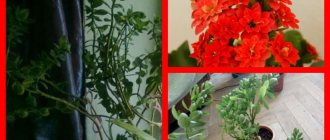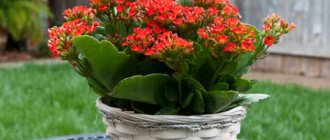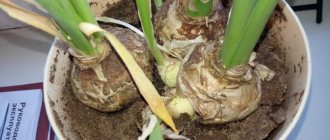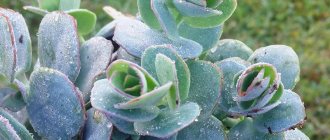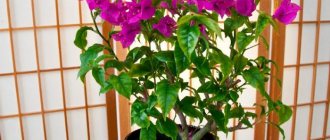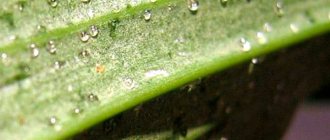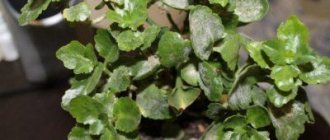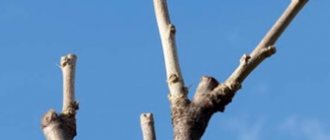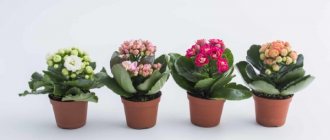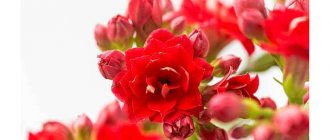What varieties of Kalanchoe need pruning?
They prune crops at home for different purposes. Sometimes it is truly necessary for the health of the crop, and sometimes pruning is just a cosmetic procedure. Just a whim of the gardener, the desire to give the green pet a beautiful crown shape.
But it is always worth considering how a certain variety tolerates the procedure at home. The red-flowered varieties are said to be able to replenish limitless amounts of cut stems and leaves.
Things are completely different for varieties with yellow and white buds. These varieties are more capricious, so you need to be careful with them when pruning at home. Excessive pruning of rare varieties can cause the death of a plant covered with yellow or white buds, so do not trim them unnecessarily.
Basic methods of plant formation
Pruning Kalanchoe pursues, first of all, the goal of giving a neat shape to the bush, and secondly, creating more favorable conditions for development and growth for the flower. The juice accumulated inside the plant spreads evenly along the stems and foliage - as a result, the plant takes on a healthier, “juicier” appearance, and its resistance to diseases and attacks by insect pests increases.
The decorative purpose of pruning is also important. With the exception of a couple of species - pinnate and Degrimona - the flower is grown as a compact and attractive, lush and beautifully flowering plant . Almost all of its varieties are characterized by rapid growth of shoots. Pruning and pinching prevent the stems from branching chaotically and help form Kalanchoe with a neat round shape that is pleasing to the eye.
The purpose of the pruning and pinching procedures is:
- formation of an attractive plant crown;
- removal of withered flower stalks and dried petals to prevent infection with diseases and increase the decorativeness of flowering;
- pruning old side shoots to rejuvenate the bush;
- removing parts of the plant that are too damaged by diseases or parasites.
Before pruning or pinching, you should accurately determine the variety of the crop - Kalandiva or the Blossfeld variety tolerate even intensive pruning, but rare hybrids that bloom in yellow, pink, and white are much more sensitive to it. An incorrectly carried out procedure can destroy them, so more often they are treated only by carefully pinching the top.
Trimming
This procedure comes in three types:
- initial - carried out immediately after the young plant has taken root and started to grow;
- preventive - helps to form a beautiful shape, and also contributes to the health of the flower by removing diseased and old shoots;
- after flowering - this frees the bush from withered peduncles, which become “provocateurs” of stem rotting. In addition, such pruning helps to obtain lush flowering next year.
Why prune Kalanchoe?
Kalanchoe is found everywhere in private houses and apartments. It has bright, bushy inflorescences and many green dense leaves. The culture is also considered medicinal.
In addition, this flower does not require special and careful care; in most cases, it blooms starting in winter and throughout the spring.
But sometimes the bush begins to grow upward uncontrollably. This appearance is not always welcomed by gardeners. In addition, if you grow Kalanchoe, you should understand the basic purposes and principles of pruning Kalanchoe after flowering and for flowering in the new season.
There are three types of Kalanchoe pruning: after purchase, sanitary and preventive pruning and pruning after flowering.
First, pruning at home is carried out in the very first days after purchasing the plant, when it takes root in your home and begins to grow: cut a couple of leaves from each of the shoots. Usually the top pair is pruned.
Sanitary and preventive pruning is carried out after detection of diseases or pests to remove infected parts, as well as to decorate the appearance of the bush.
Upon completion of flowering, pruning is carried out in order to remove interfering leaves and faded flower stalks.
You can also cut off last year's shoots after flowering. This promotes rejuvenation: nutrients flow more actively to young stems, making them more elastic and resistant to drying out.
In addition, Kalanchoe usually begins to bloom much better the next season.
IMPORTANT! When pruning after flowering, it is necessary to get rid of all flower stalks without exception.
What else is useful to know about pinching
There is one more time when it is very advisable to pinch a Kalanchoe - if it should bloom, but still does not produce buds. Please note that standing on a northern windowsill, the flower grows with noticeable effort and may not bloom. If it is located in the south, it should be pinched before December, and if it faces the west or east, on any convenient day. By caring for Kalanchoë in this way, you will undoubtedly receive gratitude from him.
Gardeners often ask questions specifically about Kalanchoe kalandiva, how to pinch this flower. The main thing to consider is that the plant needs to be thoroughly pruned immediately after flowering. Otherwise, the same instructions.
Whether it is necessary to pinch Kalanchoe - everyone decides for himself and his green pet; without this operation the plant will not die. However, let us remind you that the procedure can help the process of healthy lush growth, as well as improve the aesthetics of appearance.
When to prune Kalanchoe
Prune after flowering ends, every time after flowering. You can prune when you are sure that the plant will no longer bloom.
Flower growers recommend pruning after flowering in the morning, preferably before noon. This procedure will stimulate the formation of new shoots, this can make the Kalanchoe bloom. It is also important not to forget that late autumn and early winter is a dormant phase, so pruning is not recommended.
How to prune Kalanchoe to bloom step by step
Sometimes the bush grows in such a way that the stems become very elongated, but do not bloom. This means that the Kalanchoe will continue to grow upward without flowering. In such cases, it is necessary to perform special pruning:
- Wash your hands and prepare sharps for pruning;
- Inspect the bush and select tall stems to trim;
- Tall stems without peduncles will have to be cut almost to the root, leaving 2-3 cm above the soil;
- At home, cut stems can be further shortened (leaving literally the top 2 pairs of leaves) and stuck back into the soil for germination;
- If only a stump remains in the pot after the event, then significantly reduce watering, because now the crop does not have leaves and stems that need a lot of moisture.
Pruning Kalanchoe after flowering
As mentioned above, pruning at home after flowering has completed is required to stimulate the growth of new stems, as well as the establishment of flower stalks for future flowering. In other words, to renew the plant.
When your Kalanchoe stops blooming, you need to clean it of faded inflorescences, unopened buds and flower stalks.
This procedure should not be postponed until the petals and inflorescences are completely dry. The cut must be made at the very base; it is also better to cut off the two outer shoots.
Of course, when pruning, you need to be careful not to damage adjacent leaves and shoots.
How to prune Kalanchoe to have a beautiful bush, step by step with photos
In order for Kalanchoe to grow into a neat, beautiful bush, it needs to be trimmed correctly. At home it is not difficult, you just need to follow some order:
The top two leaves of the plant should be cut off as soon as they begin to develop. When 2 new shoots appear in this area, you need to wait until they form another new pair of leaves. At the level of development of the previous stage, the shoots need to be pruned.
Again we wait for the formation of two more new shoots with a new pair of leaves, and cut them off.
The steps described above are repeated until the required shape and volume of the bush is obtained.
ON A NOTE. When a Kalanchoe bush blooms, it is not pruned.
Features of the formation of Kalanchoe
If you do not monitor the growth of Kalanchoe, but let everything take its course, then at home its shoots can reach 50 cm in height. It's not very aesthetically pleasing. In addition, the plant does not bloom, and the shoots wither much earlier than usual. There is no need to radically cut off all the shoots and turn the flower into a stump (although some varieties are able to re-grow green mass even from this state).
To form a Kalanchoe, it is enough to cut or pinch only the tips of the shoots (above the fourth leaf) and young leaves that have not yet grown. Pinching causes much less damage to Kalanchoe than pruning. In places where the leaves were cut, the main stems begin to branch and side shoots grow.
If full-fledged shoots grow in the axils of the leaves (possibly even with peduncles), then you should not prune or damage these leaves.
Medicinal properties
Kalanchoe Degremona, along with Kalanchoe pinnate, is a medicinal representative of the Kalanchoe genus, with pronounced healing properties. Both of these types have the same medicinal properties:
- wound healing;
- hemostatic;
- anti-inflammatory;
- bactericidal
- antiallergic;
- immunomodulatory.
The presence of brood buds distinguishes Degremon from the cirrus, which has no “babies”. Another difference is that during the flowering period, Kalanchoe Degremona is considered poisonous and is prohibited from being taken orally.
The healing properties of Kalanchoe pinnate and Degremon have been recognized by official medicine and are used in pharmacology for the manufacture of medications (mainly alcohol tinctures).
The juice of this type of Kalanchoe, contained in the stems and leaves, has healing properties. Application in medicine has a fairly wide range - gynecology, ophthalmology, surgery, etc.
If you or your loved ones often suffer from colds, then be sure to place this plant in the room where you spend a lot of time. It is able to defeat influenza viruses and other pathogenic microbes and microorganisms.
Juice
Kalanchoe Degremona juice is very often used in the treatment of runny nose. One has only to drip it in and the disease quickly begins to recede.
To prepare tincture and juice, you should take leaves that are located close to the base. The juice tastes bitter, with a slight sourness. You can store it for a long time - it does not spoil. It is very good to have squeeze in stock, especially if there are small children in the house. This juice is good for treating wounds, cuts, abrasions, ulcers and burns, as it has excellent wound healing agents.
This flower is also known for its anti-inflammatory properties. It is very good to make compresses from it. Adding raw egg white will enhance the effect of the juice.
Alcohol tincture
Alcohol tincture is often used to prevent and treat colds. It’s not difficult to make: the cut leaves should be left in a dry and cool place for a week. After this, grind them into porridge and squeeze out the juice, which must be placed in the cold for another two days. After this time, mix the juice of Kalanchoe Degremon with alcohol (20% strength) in a ratio of 1:20. Keep refrigerated.
Ointment
It is more convenient and effective to use ointment to treat wounds. It is very simple to prepare: Grind the leaves of Kalanchoe and squeeze out the juice from them, which we mix with lanolin or petroleum jelly in the proportion of 30 ml of juice per 50 grams of base.
How and when to pinch Kalanchoe at home
Just a few days after the first planting of the Kalanchoe, it is necessary to pinch it: only a couple of outer leaves are left on each shoot. As new shoots with leaves grow, pinching is repeated. This procedure is carried out until the correct shape of the bush with branching is formed.
Pinching should be done regularly so that the plant does not stop blooming and the stems do not become thinner due to lack of nutrients.
If a plant does not bloom, this is not the most unpleasant consequence: if you do not pinch the flower in time, it may simply begin to dry out. Always carefully inspect the crop: if you find weakened shoots, remove them immediately (you can use scissors, or you can pinch them off with your fingers).
If you pinch a flower with your hands, they must be clean.
INTERESTING! There is a type of Kalanchoe that independently maintains a neat shape without pinching - Degremona. There is also an informal name for this species, which it received for its medicinal properties - “doctor”.
What you need to know before pinching
The heroes of our article belong to plants that have been used for medicinal purposes since ancient times.
The heroes of our article belong to plants that have been used for medicinal purposes since ancient times. Juice was squeezed out of their leaves, which had an anti-inflammatory effect, used on wounds, burns, and even against the “scourge of humanity” - the common cold (for which, until now, there are almost no more effective medicines). Especially after pinching, Kalanchoë grows quickly,
Although almost all varieties of Kalanchoë require pinching, there are certain species that do not need pinching - they already have a complete shape all year round, without the shoots that periodically dry out at the ends of other species. One of these is the most famous of all, among scientists and gardeners it is called Degremona, and among the people it received the honorary name “doctor” (or “surgeon”), for its exceptional medicinal properties. And also – “crocodile”, behind the fleshy jagged leaves growing in pairs, between which the “younger generation” huddles. Although this Kalanchoe withstands pinching firmly, and if desired, this can be done, after this procedure it grows side shoots without much zeal.
How to care for Kalanchoe after pruning so that it blooms
After pruning, the flower needs rest. What does it mean?
It is necessary to reduce watering of the plant (once every 4-6 weeks), move the flowerpot with the bush to a less bright and cool space (without direct sunlight, ambient temperature no more than 16°C).
Watering Kalanchoe is carried out at the root or on a tray under the pot. The water should be soft, room temperature.
Thanks to this care, the Kalanchoe will begin to bloom again after a while.
Transfer rules
Adult Kalanchoe with “babies”
Kalanchoe is a plant that grows very quickly, so it needs to be replanted at least once every two years. When? Better in early spring.
To transplant Kalanchoe, it is recommended to use the “transfer” method, transferring the plant into a pot that will be larger than the previous one by at least 2 cm in radius.
You need to be quite careful when pulling out the plant, since Kalanchoe has very fragile leaves and stems. It is better to use soil that is as similar as possible to the previous one; it is recommended to add humus to the soil.
Common mistakes
- If you do not remove Kalanchoe flower stalks after flowering by cutting them off at the very base, they will begin to rot;
- Kalanchoe Degremona after pinching (if you still wanted to do it) will either not grow side shoots at all, or this will happen slowly, not very actively;
- Hybrid varieties are quite difficult to tolerate pruning, so it is recommended to only pinch out their tops;
- A few hours after watering the Kalanchoe, excess water from the tray must be drained to prevent rotting of the root system;
- Inflorescences that no longer bloom begin to fade; if you do not get rid of them after flowering, this can lead to flower diseases.
Answers to frequently asked questions
How long should the dormant period of Kalanchoe last after pruning?
It takes about a month for Kalanchoe to bloom again after the annual pruning procedure.
What tools are best for pruning Kalanchoe at home?
It is important that the tool is sharp: a sharpened table knife or a stationery blade will do.
When should you stop pruning Kalanchoe?
The last pruning of Kalanchoe should be carried out no later than the end of autumn (November), before the flower goes dormant.
Recommendations and rules for forming a bush
Timely and correct pruning promotes the growth of a beautiful Kalanchoe bush with lush inflorescences. The crown formation process has nuances that you need to know.
- Before starting the procedure, the type of plant is determined, since the pruning method will depend on it.
- You cannot prune a newly acquired crop; give it time to acclimatize to new conditions.
- You should not prune in the winter when the flower is dormant.
- You need to use a sharp utility knife or pruning shears. Disinfect the tool before use.
- Do not pick off leaves and inflorescences with your hands - the plant will be damaged and begin to wither.
- Kalanchoe should be pruned in the morning or evening, avoiding exposure to bright sunlight on the crop during the procedure.
- Treat the cut areas with crushed charcoal.
- Do not pinch the plant immediately after transplanting. Rooting and adaptation takes 2–3 weeks.
- There is no need to prune Kalanchoe that shows signs of disease or pests. They begin to form a bush no earlier than 15 days after the complete destruction of insects.

